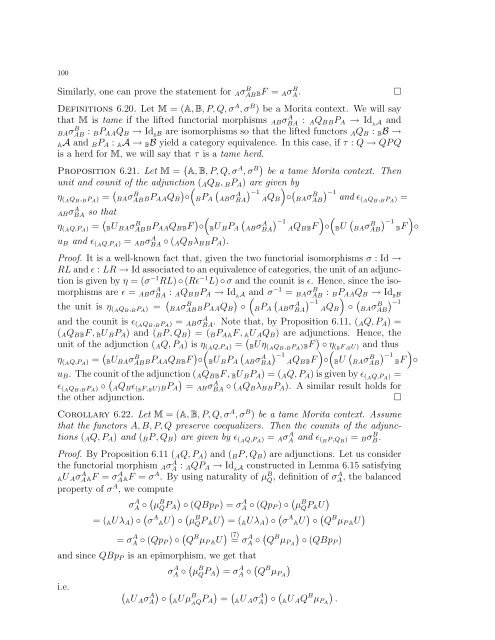Contents 1. Introduction 2 2. Preliminaries 4 2.1. Some results on ...
Contents 1. Introduction 2 2. Preliminaries 4 2.1. Some results on ...
Contents 1. Introduction 2 2. Preliminaries 4 2.1. Some results on ...
You also want an ePaper? Increase the reach of your titles
YUMPU automatically turns print PDFs into web optimized ePapers that Google loves.
100Similarly, <strong>on</strong>e can prove the statement for A σ B ABBF = A σ B A .Definiti<strong>on</strong>s 6.20. Let M = (A, B, P, Q, σ A , σ B ) be a Morita c<strong>on</strong>text. We will saythat M is tame if the lifted functorial morphisms AB σ A BA : AQ BB P A → Id A A andBAσ B AB : BP AA Q B → Id B B are isomorphisms so that the lifted functors A Q B : B B →AA and B P A : A A → B B yield a category equivalence. In this case, if τ : Q → QP Qis a herd for M, we will say that τ is a tame herd.Propositi<strong>on</strong> 6.2<str<strong>on</strong>g>1.</str<strong>on</strong>g> Let M = ( A, B, P, Q, σ A , σ B) be a tame Morita c<strong>on</strong>text. Thenunit and counit of the adjuncti<strong>on</strong> ( A Q B , B P A ) are given byη (A Q B , B P A ) = ( ) () )BAσABBP B AA Q B ◦ BP A(ABσ BAA −1AQ B ◦ ( BAσAB) B −1and ɛ(A Q B , B P A ) =ABσBA A so thatη (A Q,P A ) = ( BU BA σABBP B AA Q BB F ) () (◦(BU B P A ABσBA) A −1AQ BB F ◦ BU ( )BAσAB) B −1BF ◦u B and ɛ (A Q,P A ) = AB σBA A ◦ ( AQ B λ BB P A ).Proof. It is a well-known fact that, given the two functorial isomorphisms σ : Id →RL and ɛ : LR → Id associated to an equivalence of categories, the unit of an adjuncti<strong>on</strong>is given by η = (σ −1 RL) ◦ (Rɛ −1 L) ◦ σ and the counit is ɛ. Hence, since the isomorphismsare ɛ = AB σBA A : AQ BB P A → Id A A and σ −1 = BA σAB B : BP AA Q B → Id B Bthe unit is η (A Q B , B P A ) = ( ) () )BAσABBP B AA Q B ◦ BP A(ABσ BAA −1AQ B ◦ ( )BAσABB −1and the counit is ɛ (A Q B , B P A ) = AB σBA A . Note that, by Propositi<strong>on</strong> 6.11, ( AQ, P A ) =( A Q BB F , B U B P A ) and ( B P , Q B ) = ( B P AA F , A U A Q B ) are adjuncti<strong>on</strong>s. Hence, theunit of the adjuncti<strong>on</strong> ( A Q, P A ) is η (A Q,P A ) = ( BUη (A Q B , B P A )BF ) ◦ η (B F , B U) and thusη (A Q,P A ) = ( BU BA σABBP B AA Q BB F ) () (◦(BU B P A ABσBA) A −1AQ BB F ◦ BU ( )BAσAB) B −1BF ◦u B . The counit of the adjuncti<strong>on</strong> ( A Q BB F , B U B P A ) = ( A Q, P A ) is given by ɛ (A Q,P A ) =ɛ (A Q B , B P A ) ◦ ( )AQ B ɛ (B F , B U)BP A = AB σBA A ◦ ( AQ B λ BB P A ). A similar result holds forthe other adjuncti<strong>on</strong>.□Corollary 6.2<str<strong>on</strong>g>2.</str<strong>on</strong>g> Let M = (A, B, P, Q, σ A , σ B ) be a tame Morita c<strong>on</strong>text. Assumethat the functors A, B, P, Q preserve coequalizers. Then the counits of the adjuncti<strong>on</strong>s( A Q, P A ) and ( B P , Q B ) are given by ɛ (A Q,P A ) = A σ A A and ɛ ( B P ,Q B ) = B σ B B .Proof. By Propositi<strong>on</strong> 6.11 ( A Q, P A ) and ( B P , Q B ) are adjuncti<strong>on</strong>s. Let us c<strong>on</strong>siderthe functorial morphism A σA A : AQP A → Id A A c<strong>on</strong>structed in Lemma 6.15 satisfyingAU A σAAF A = σAAF A = σ A . By using naturality of µ B Q , definiti<strong>on</strong> of σA A , the balancedproperty of σ A , we computeσA A ◦ ( )µ B QP A ◦ (QBpP ) = σA A ◦ (Qp P ) ◦ ( µ B QP A U )= ( A Uλ A ) ◦ ( σ A AU ) ◦ ( µ B QP A U ) = ( A Uλ A ) ◦ ( σ A AU ) ◦ ( Q B µ P A U )= σ A A ◦ (Qp P ) ◦ ( Q B µ P A U ) (7)= σ A A ◦ ( Q B µ PA)◦ (QBpP )and since QBp P is an epimorphism, we get thatσ A A ◦ ( µ B QP A)= σAA ◦ ( Q B µ PA)i.e.( ) ) ( ) ( )AU A σAA ◦(AUµ B AQP A = AU A σAA ◦ AU A Q B µ PA .□
















